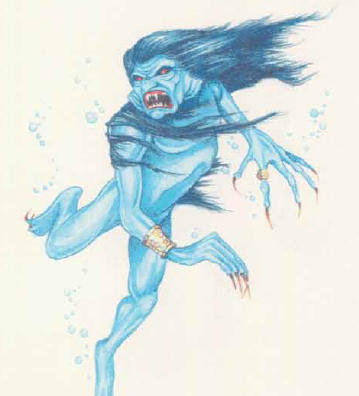* The Vampire, Nosferatu isn't in the earlier Creature Catalogue (AC9).
Tabi.
Flying monkeys that can be bound (6th level Wizard spell in 2e) as familiars and spies. They are long-lived (though hardly ancient: 150 years in 2e) and give off a stench of rot that can be smelled at up to 100 feet.
Claws drip a crystal blue venom that causes you to attack whoever's nearest to the best of your ability, but only with weapons or unarmed attacks. Thief abilities. Like to ambush, then hide while their victims fight it out with each other.
I liked this a lot more as just a statblock in the Master DM's book with limited clues to what it was, but I think lots of people have time for winged monkeys (with or without dear little uniforms).
Thunderhead.
Because I'm not keen on the standard dragon, I like borderline cases such as the Thunderhead - a dragon-like fantastic animal that lives in the clouds and loves an electrical storm (encounter one during and it doubles its HD).
 |
| Pretty cool. |
They're black in colour with a lightning bolt breath weapon, and can carry off a war horse in its claws, so this is a dragon as far as most normal folk are concerned. And I'm not going to quibble.
Topi.
Culturally dubious shrunken undead - smaller (2' tall), tougher and more agile (they can jump) Zombies with slow venom. The process of making them is known only to certain primitive tribes, because head-hunters or voodoo or something.
Caricatures aside, I think they're a sound little monster and a sound little statblock for reskinning. I especially like the inclusion that hitting them with a bludgeoning weapon knocks them over and they lose their next attack.
2e uses tribal, witch doctor and shaman to indicate the certain primitive tribes aspect, and includes the usual greater detail for creating one and how its abilities interact with the expanded AD&D rules. They also get a slight boost in intelligence, making them capable of carrying out orders without close supervision and taking pleasure in killing.
Tortle.
Terrapin/tortoise/turtle people. See also, Snapper. Apparently quite popular nowadays.
Can retreat inside their shells for (in CC) undefined protection. You can use the shells of 25 of their freshly harvested eggs to make lightweight plate mail armor. And they prefer to travel on horse-drawn wagons when not bobbing along in the water.
They travel to traditional, stone-walled compounds near the end of their lives to lay eggs, barricade them in, and then die. Doesn't say if this happens en masse or individually, but I find the whole thing conjures a somewhat bleak image.
2e changes this to females lay eggs only once during their lives and aging males then watch over the eggs, dying once they are safely hatched. Which is also kind of bleak. Though the text would imply that the other Tortles stick around (maybe having a carnival or solemn rites) rather than leave the eggs and the elderly, I think I'd lean into the bleakness on this one.
I like them more than I would expect now I've considered their lifecycle.
Triton.
Higher (5 to 7) HD merfolk with level-equivalent spell-casting ability (50/50 Cleric or MU - no fire spells). Sparse cultural/habitat detail - they braid their hair and build cities that are works of art.
Different enough to the MM that you could use both. They could share tridents.
Vampire, Nosferatu.*
This is a special vampire, in that it's the more traditional blood-drinking rather than level-draining one.
Surprisingly short compared to almost every other Vampire entry in almost every other game.
Guess what? Turned as a Vampire by Clerics.
There's a version in 2e, but it's part of the Ravenloft setting. There are a number of differences, not least that it has mechanics for blood-drinking, rather than merely a d4 bite and dietary preferences.
Vampire Rose.
They flush red from white after they've fed on d8 hp of your blood per round. Save vs. spells or you are hypnotically anaesthetised (so I'm not clear if this is a chemical or a magical effect) and let them do it.
They can uproot themselves and move about, albeit slowly, which is creepy.
2e states that the hypnotic effect is from the plant's fragrance, and adds the wonderful feature that it screams and spurts blood if you can sever a part of it while it feeds. Save vs. fear if this is the first time you've experienced this.
Now one of my favourite plant monsters.
Velya.
Take a Vampire entry (almost any will do). Swap around what they can turn into (shark, ray, water) and what they're particularly vulnerable to (destroyed by exposure to open air), but they're otherwise much the same (the Velya has a weaker statline).
However, that doesn't mean I don't like the Velya. In fact, I've always thought it was pretty cool.
Its charm person power is a thematically appropriate song, and they're normally accompanied by 1d6 wights (victims return as Wights, not more Velyas).
There's also a swamp variant of this variant (turns into albino croc, white eel, water; not vulnerable to open air, as long as it's in contact with the swamp).
 |
| As featured (with Wight; by Jeff Butler) in X7 War Rafts of Kron. |
For some reason, both CC and 2e seem to have settled on that Wight rather than the actual Velya for inspiration:




